The Best Guide To News Articles
The Best Guide To News Articles
Blog Article
Things about News Articles
Table of ContentsWhat Does News Articles Mean?The Ultimate Guide To News ArticlesThe smart Trick of News Articles That Nobody is DiscussingNews Articles Can Be Fun For AnyoneNews Articles Things To Know Before You Buy
Good understanding of different subjects offers pupils an one-upmanship over their peers. Even though digital and social media are easily easily accessible, we must not fail to remember just how vital it is to review the papers. Moms and dads should try and instill the habit of reviewing a newspaper as a day-to-day routine to proceed the heritage of the revered print medium.News tales additionally contain at the very least among the adhering to essential qualities family member to the desired audience: closeness, prominence, timeliness, human interest, quirk, or consequence. The associated term journalese is often made use of, usually pejoratively, to describe news-style writing. Another is headlinese. Papers typically stick to an expository writing design.
Within these restrictions, information tales likewise aim to be thorough. Amongst the larger and much more respected papers, fairness and balance is a significant element in offering info.
Papers with a global audience, for example, often tend to make use of an extra formal style of writing. The certain selections made by an information electrical outlet's editor or editorial board are frequently collected in a design overview; typical style overviews consist of the and the US News Design Book. The primary goals of information writing can be summed up by the ABCs of journalism: accuracy, brevity, and quality.
Get This Report on News Articles
As a rule, reporters will not utilize a lengthy word when a brief one will do. Information writers try to stay clear of making use of the same word extra than as soon as in a paragraph (occasionally called an "resemble" or "word mirror").
Nonetheless, headings in some cases omit the topic (e.g., "Jumps From Boat, Catches in Wheel") or verb (e.g., "Feline lady lucky"). A subhead (likewise subhed, sub-headline, subheading, caption, deck or dek) can be either a subordinate title under the main heading, or the heading of a subsection of the short article. It is a heading that precedes the primary message, or a team of paragraphs of the main message.

Added signboards of any of these kinds may show up later on in the write-up (specifically on succeeding web pages) to tempt further analysis. Such billboards are also used as tips to the post in various other sections of the magazine or site, or as advertisements for the item in other magazine or sites. Normal structure with title, lead paragraph (recap in bold), various other paragraphs (details) and call info.

Example of a hard-lead paragraph NASA is recommending an additional room project. The budget demands around $10 billion for the task.
The NASA news came as the agency requested $10 billion of appropriations for the job. An "off-lead" is Get the facts the second crucial front web page information of the day. The off-lead appears either in the leading left corner, my latest blog post or directly below the lead on the right. To "bury the lead" is to begin the write-up with background information or information of second significance to the viewers, forcing them to learn more deeply right into a short article than they must need to in order to discover the crucial factors.
The Facts About News Articles Revealed
Typical usage is that or more sentences each form their own paragraph. Reporters typically describe the company or structure of an information tale as an upside down pyramid. The essential and most intriguing components of a story are placed at the start, with supporting information adhering to in order of reducing value.
It enables individuals to discover a topic to just the depth that their curiosity takes them, and without the charge of details or nuances that they can think about pointless, yet still making that details readily available to extra interested viewers. The inverted pyramid framework additionally enables short articles to be cut to any kind of arbitrary length throughout layout, to fit in the room offered.
Some authors start their stories with the "1-2-3 lead", yet there are numerous kinds of lead readily available. This style invariably starts with a "5 Ws" opening up paragraph (as described over), followed by an indirect quote that serves to sustain a significant aspect of the first paragraph, and after that a straight quote to support the indirect quote. [] A twist can describe several things: The last tale in the information broadcast; a "delighted" tale to finish the show.
Longer short articles, such as publication cover articles and the pieces that other lead the within areas of a newspaper, are understood as. Attribute tales differ from straight news in numerous ways.
Excitement About News Articles
The reporter usually information interactions with interview topics, making the item more personal. A feature's very first paragraphs frequently associate an intriguing moment or occasion, as in an "anecdotal lead". From the details of a person or episode, its sight promptly expands to generalizations concerning the story's subject. The area that indicates what a feature has to do with is called the or signboard.

The Editor's Tool kit: A Recommendation Guide for Beginners and Professionals (2001) Allan M. Siegal and William G. Connolly. The New York Times Manual of Style and Use: The Authorities Design Guide Used by the Writers and Editors of the Globe's Many Authoritative Newspaper (2002) M. L. Stein, Susan Paterno, and R.
Report this page